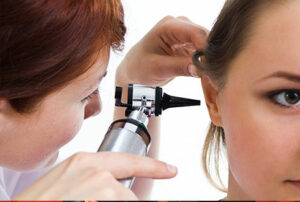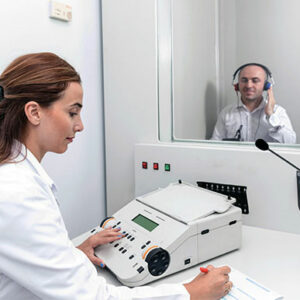Free Hearing Check
No Appointment Necessary

You can drop into any of our clinics at any time for a free, 5-minute hearing evaluation using our touchscreen screeners.
A video guide will walk you through a hearing check designed to determine the lowest volume of noises you can hear at frequencies crucial to human hearing. Results will be displayed on the screen, and an email with a copy will be sent to you.
We will advise a thorough clinical hearing test and consultation with one of our audiologists if your free hearing check reveals a serious hearing loss.
- No appointment is required.
 To assess the health of the eardrum and ear canal, this simply entails looking into the ear canal with an otoscope. It helps determine whether there are any obvious issues that could affect the outcomes of hearing tests, such as ear infections, impacted ear wax, and tympanic membrane perforation (eardrum perforation).
To assess the health of the eardrum and ear canal, this simply entails looking into the ear canal with an otoscope. It helps determine whether there are any obvious issues that could affect the outcomes of hearing tests, such as ear infections, impacted ear wax, and tympanic membrane perforation (eardrum perforation).
Air conduction
 Pure tone audiometry is the simplest procedure for evaluating hearing. This entails listening to a sequence of beeps, known as pure tones, while seated in a soundproof booth (see photo), and indicating when you can hear them, usually by pressing a button.
Pure tone audiometry is the simplest procedure for evaluating hearing. This entails listening to a sequence of beeps, known as pure tones, while seated in a soundproof booth (see photo), and indicating when you can hear them, usually by pressing a button.
Each tone is lowered in volume until it is hardly audible. Finding the quietest noises that you can hear at the entire range of frequencies typical of human speech—typically 250 Hz to 8000 Hz—is the goal of the test.
An audiogram is a graph that indicates your hearing thresholds, or the quietest sounds you can hear.
Bone conduction
By inserting a tiny vibrator on the mastoid bone behind the ear and measuring the softest noises that can be heard, the cochlea’s sensitivity can also be checked. This method of sound presentation bypasses the middle ear, sending sound directly to the cochlea and hearing nerves through the skull’s bones.
We can learn a lot about the location of a hearing impairment by comparing air conduction and bone conduction hearing levels.
A ruptured tympanic membrane, fluid in the middle ear, excessive ear wax, sensory impairment over time, or malfunctioning middle ear bones are a few potential causes.
Your capacity to recognise and comprehend speech sounds is fundamental to hearing. Unfortunately, when hearing is impaired, the quality of the sound is frequently distorted, as well as a loss of volume.
Speech tests are used to assess a person’s ability to understand speech without the aid of visual cues like lipreading. They often involve playing (or speaking) popular word lists at a consistent volume that are suitable for the client’s hearing loss.
The customer responds by speculating on the word that was said, and the number of right and wrong answers is recorded.
Speech-in-Noise Tests
As people with hearing loss frequently have the most difficulty understanding speech in the presence of background noise, speech discrimination are often conducted with the addition of a “noise” stimulus. Commonly, words or phrases are played with a backing track of “speech babble” or common background noises.
Unaided vs. Aided Tests
Your Hearing Care Professional may repeat the speech tests after a hearing aid has been fitted. This will identify the improvement in the speech test results when you’re wearing a hearing aid.
Tympanometry evaluates the eardrums flexibility and movement to determine whether it is moving normally.
Results could point to a middle ear issue that could be the root of a conductive hearing loss. It could be possible to examine a child’s middle ear for the presence of an acoustic reflex if their tympanogram is normal. The auditory system’s functionality is revealed by the absence of this responsiveness to various noises


 To assess the health of the eardrum and ear canal, this simply entails looking into the ear canal with an otoscope. It helps determine whether there are any obvious issues that could affect the outcomes of hearing tests, such as ear infections, impacted ear wax, and tympanic membrane perforation (eardrum perforation).
To assess the health of the eardrum and ear canal, this simply entails looking into the ear canal with an otoscope. It helps determine whether there are any obvious issues that could affect the outcomes of hearing tests, such as ear infections, impacted ear wax, and tympanic membrane perforation (eardrum perforation). Pure tone audiometry is the simplest procedure for evaluating hearing. This entails listening to a sequence of beeps, known as pure tones, while seated in a soundproof booth (see photo), and indicating when you can hear them, usually by pressing a button.
Pure tone audiometry is the simplest procedure for evaluating hearing. This entails listening to a sequence of beeps, known as pure tones, while seated in a soundproof booth (see photo), and indicating when you can hear them, usually by pressing a button.